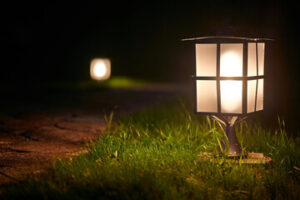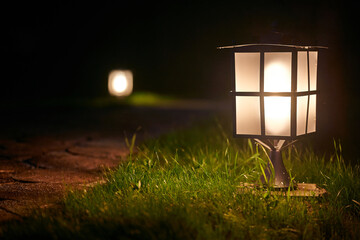A well-maintained landscape lighting system adds allure and value to outdoor living spaces. Periodically reevaluate and adjust lighting to accommodate changes in the landscape and property.
Blown bulbs and faulty connections are common, but a light that won’t turn on points to more significant issues like corroded wires or a failing transformer. A professional inspection and repair service can identify these problems quickly and restore functional lighting. Contact Landscape Lighting Repair Orlando for professional help.
Landscape lighting adds a beautiful ambiance to your garden and yard at night. It can also increase the curb appeal of your home and boost its value. To get the most out of your landscape lighting system, it’s important to keep up with routine maintenance. These simple tasks can help you avoid costly repairs and enjoy the best possible results from your system.
A good way to start your maintenance is with a walk-around of all the lights. Flip the switch on and off and look at each fixture for signs of damage or wear. If you notice a light isn’t working, check the bulb to see if it needs replacing. It’s also a good idea to replace the bulbs on an annual basis. LED bulbs last longer and use less energy, so they can save you money in the long run.
Next, inspect the fixtures themselves for rust or corrosion, especially around the wire connections. These wiring connections are how electricity reaches the lights, so any damage can cause them to stop working or even be a safety hazard. If you’re noticing signs of these problems, it’s a good time to consider upgrading your landscape lighting system to a newer model. Lighting technology has come a long way in recent years and today’s systems perform much better than older models.
Another step in maintenance is to clear away any debris that has accumulated on or near the fixtures. This can include things like fallen leaves, mud and dirt, cobwebs and wasp nests. This will help keep the fixture from corroding or being blocked by anything.
It’s also a good idea to trim any tree branches, bushes and other plants that are growing too close to the fixtures. This can prevent them from being covered or damaged by mowing equipment and reduce the risk of power lines getting cut. In addition, it’s a good idea to keep a list of the locations where the lighting is located so maintenance crews can easily locate them when they’re working in the garden or yard.
Wiring and Connections
Lighting systems use a complex network of wires to distribute power and provide illumination. Wires need to be able to withstand outdoor elements, including moisture and dirt, as well as the potential for being pulled out by animals or landscaping activities. Low-voltage wires must also be buried deep enough to prevent accidental damage during landscape or gardening activities and to protect against ground movement and weather changes that could disrupt or cause a short circuit.
Keeping all of these components in good working order requires periodic maintenance and inspections. A regular professional cleaning of fixture lenses and other surfaces can help keep them looking their best, while a careful examination of wiring and connections can detect any corrosion or problems that may need immediate attention.
Flickering Lights
Several issues can cause flickering lights in your landscape lighting system, from a simple burnt-out bulb to a faulty transformer. A professional can help you determine the source of the problem and make the necessary repairs to restore full functionality.
Lights that Won’t Turn On
If one or more of your landscape lights fail to turn on, it is a sign of a larger electrical issue. It is important to have these problems addressed as quickly as possible to minimize the impact on your home’s safety and security.
Faulty Timers and Transformers
If the timing settings on your landscape lighting system are incorrect, it can result in a lot of wasted energy or even system shutdown. A trained technician from NightVision Outdoor Lighting can ensure that these crucial controls are functioning properly and identify any potential problems.
Dimming Lights
As your landscape matures, it is common for some of the lights in your landscape to become dimmer over time. This can be caused by a variety of factors, from dirt or mineral deposits on the fixture lenses to low voltage from aging bulbs.
A well-lit property improves safety and security by reducing the risk of trips and falls and deterring unwanted intruders. It also makes your property more appealing by highlighting its best features and enhancing the overall aesthetic. Regular landscape lighting maintenance and repair services from an experienced and qualified technician can maximize the benefits of your investment and ensure that your lighting system performs at its peak.
Transformers
Landscape lighting can elevate a home’s curb appeal at night, creating a warm and inviting atmosphere. But when fixtures stop working, it can be frustrating and even a safety risk. Effective landscape lighting repair practices can restore your outdoor glow.
Electrical problems are often the source of malfunctioning landscape lighting. Faulty wiring, which can be caused by exposure to the elements, rodents chewing on wires, and accidental damage from lawn care equipment, can cause lights to flicker or stop working. These issues can be difficult to diagnose and require professional services.
Inspecting your fixture components on a regular basis helps prevent them from becoming damaged or broken. Start with inspecting the lenses and housings for signs of deterioration. Look for cracks, loose connections, or any evidence of water infiltration, which can lead to rust and electrical short circuiting. Clearing any dirt, debris, or cobwebs from the fixture can also help ensure that the light is functioning properly.
Another common problem is a low wattage output, or “lumens.” A light’s lumens are a measure of its brightness. When replacing bulbs, choose those with a similar wattage or your landscape lighting may not shine as brightly.
Low-voltage transformers are crucial for landscape lighting systems, converting household voltage to a safer, lower level for outdoor illumination. These units are rated in kVA, which combines real power (kW) for actual use and reactive power (kVAR) used by motors and inductors. When a transformer is overloaded, it will begin to overheat and shut itself off.
While a quality landscape lighting system is designed to last for decades, normal wear and tear or electrical problems can cause it to need repairs or upgrades. Upgrading to newer lighting components, such as transformers and wires, improves efficiency, reliability, and performance.
Effective landscape lighting repair and maintenance practices can prevent costly repairs, extend the lifespan of your fixtures, and ensure a safe and enjoyable experience. Learn more about the best landscape lighting techniques and tips by contacting the experienced professionals at NightVision Outdoor Lighting today. We’ll help you find the perfect solutions for your unique lighting needs, providing a picture-perfect evening glow that enhances your home’s beauty and value.
Tools
In order to repair landscape lighting, homeowners must first make sure they have the right tools on hand. A good start would be a six to ten piece screwdriver set that includes nonslip handles. This should work well for most brands of lighting. Additionally, a multimeter is a helpful tool to have for assessing voltage drop, inspecting wiring and switches, and measuring the quality of connections. Having insulated tools is also essential to prevent electrical shock when working with electrical components.
Once you have the necessary tools, it’s time to begin troubleshooting. Before beginning any repairs, make sure the power is completely off at the transformer. Then, walk around your yard to check each light fixture to ensure that it is operating correctly. If a fixture is not working, turn it off and try resetting the fuse or replacing the bulb.
If the problem persists, it may be a good idea to switch out older bulbs for LED bulbs. These are energy-efficient and last much longer than traditional bulbs. If you decide to replace your bulbs, make sure they are the same wattage and color temperature as the originals for uniform lighting.
Other common issues include clogged fixtures and wires that are not properly connected. Inspect each fixture regularly to remove any dirt and debris that could be causing them to stop functioning properly. Also, consider upgrading your system with newer technologies that can save you money and improve your safety and security.
Keeping your landscape lighting in good shape is a simple process with the proper knowledge and tools. With regular cleaning and inspections, you can avoid many problems that might otherwise be difficult to fix. By knowing what types of problems are most common, you can keep your system in top shape for years to come.
Whether illuminating pathways, accentuating architectural features, or creating a warm ambiance for evening gatherings, the right landscape lighting can add a magical element to any outdoor space. But if the lights go out or are flickering, all that beauty is lost. Luckily, many of these problems are easy to diagnose and fix. With a little know-how and the right tips, you can keep your landscape lighting shining brightly all year round.

